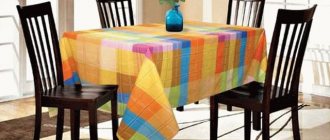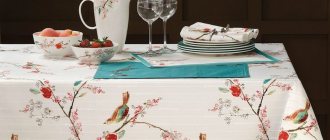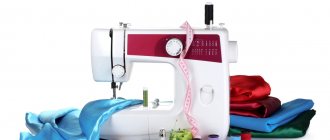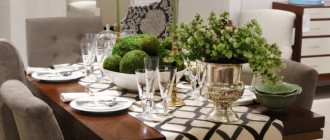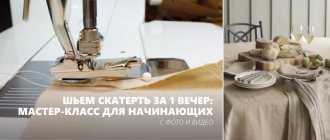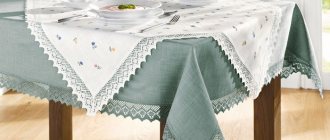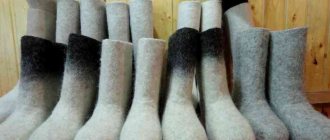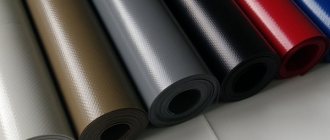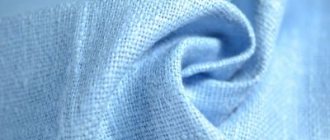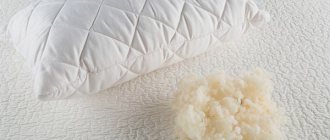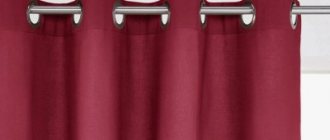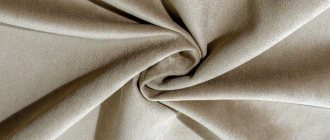Reading time: 3 minutes. Published
A tablecloth is an indispensable attribute of any holiday and celebration. In addition to aesthetic qualities and creating an atmosphere, such products also have a practical benefit - they protect the table surface from contamination.
This is especially true for coatings with special water-repellent impregnation. Such products effectively remove moisture from the base material and reduce its wear. How to wash a Teflon tablecloth to protect the product from rapid wear and tear?
Description
Most housewives associate Teflon with the special coating of frying pans. Not long ago, fabric impregnated with it appeared. It is used for sewing workwear and upholstery. Home textiles are not left out either, because a tablecloth that will repel water, dirt and dust is the dream of any housewife. Liquid spilled on such matter is not absorbed into it, but remains on the surface as a puddle that can be easily blotted with a sponge.
Thanks to the Teflon coating, the attractive appearance of the tablecloth is preserved; the design, colors and shades do not wear out or fade.
Teflon improves the quality characteristics of the fabric from which the tablecloth is made.
But what types of tablecloths there are for restaurants and which ones are chosen most often are indicated in this article.
Advantages of Teflon coating:
- does not absorb fat;
- does not get wet;
- easy to care for.
Flaws:
- Low heat resistance. The integrity of the coating is destroyed at high temperatures. Do not place very hot dishes on the tablecloth.
- It does not tolerate the effects of abrasive particles well; it should not be scratched with sharp objects or a metal brush.
"Indications" for use
A Teflon-coated tablecloth can be selected for all occasions:
- on every day. There is a large selection of offers with calm, practical colors and dense Teflon impregnation. They are durable, wear-resistant, and can withstand repeated use.
- on holiday. Fabric with a festive design, such as white with decorative perforations, looks especially festive. And random stains on it will not ruin your mood, because they are very easy to remove.
- textiles for public catering places : canteens, cafes, restaurants. Serving them will always be neat.
- In summer, at the dacha , open terraces, balconies, practical canvases will be very appropriate. There will be no traces of wine, juice or fruit left on them.
You may also be interested in information about what a tablecloth looks like on a kitchen table.
This is interesting: Tablecloth for the kitchen table: description, water-repellent, coated
Nuances of caring for Teflon products
Fabric with a protective layer requires special care, as it is made of delicate material. With frequent washing, it quickly becomes unusable and loses its quality. Therefore, it is worth considering tips on how to wash a Teflon-coated tablecloth. If you dry it outside, keep it out of direct sunlight.
To extend the service life, it is recommended to use simple laundry soap or detergents without aggressive components that can be used in washing machines.
Linens made from natural fabrics shrink after washing. Therefore, when purchasing, it is important to take into account that the tablecloth should not be cheap. Well-known manufacturers offer a length reserve for shrinkage. It is worth noting that options made from polyester and acrylic fibers hold their shape perfectly, despite the fact that these are cheap products.
Linen and jacquard tablecloths
Care:
- Wash light linen and jacquard tablecloths up to 90 C.
- Water for colored items should not exceed 40 C. It is advisable to wash them separately from light tablecloths, otherwise the white color may turn into another and then it will no longer be possible to bleach it.
- Linen and jacquard should be ironed in the steam mode.
- You should not use starch when ironing, as it can damage the structure of the fabric, and it will serve less and lose its appearance and rich color.
- Iron slightly damp, and if there is embroidery, it is best to iron from the wrong side.
- Linen tablecloths should be stored ironed.
- It is recommended to dry this item in the fresh air.
It is also important to properly remove dirty and old stains, because if they are left, the product can be safely thrown away.
Removing stains:
- Red wine is removed with a solution of potassium permanganate, then with a solution of hydrogen peroxide.
- Clean the fabric from light drinks with a solution of soap, soda, and water. All this must be mixed in equal proportions. Then soak the contaminated surface in this mixture and leave for a day.
- Coffee stains can be removed with glycerin; you need to soak the stained area and leave it for a couple of hours, then wash the area in warm water.
What to look for when choosing a water-repellent tablecloth
The purpose of the tablecloth is the main selection criterion. An ordinary, simple, beautiful fabric is quite suitable for festive events. In addition to elegant options, there are tea parties and casual dinners at the family table. The owner of the house understands how important it is to protect things from all kinds of stains. A water-repellent tablecloth on the table can be washed without any problems, returning it to its original appearance, despite splashes from food with elements of fat, natural and artificial dyes. Choosing and purchasing a tablecloth requires taking into account the interior and overall dimensions of the table. It is necessary to take into account the quality of the fabric and its components.
Classic interior design requires plain or jacquart variations in shades.
Water-repellent fabrics are made from natural (cotton, linen) and synthetic fibers (polyester). Teflon, a visually invisible compound that prevents the penetration of moisture, is applied last.
Polyester tablecloth
The strongest and most durable fabric is polyester.
Advantages: polyester hardly wrinkles and does not stain.
Care: Wash in water no more than 50 C for colours, and up to 90 C for whites. All details must be indicated on the label.
It burns very easily, so when decorating a table with candles, this should be taken into account first.
Recommendations for washing
It is permissible to wash a Teflon tablecloth at a temperature of 30-40 degrees with the addition of powder or soap. It is recommended to wash it by hand, since twisting and strong spinning are contraindicated for this tablecloth. After washing the tablecloth, just wait until the water drains from it, then shake it and it will not be wrinkled. Washing in a washing machine is also possible, but you need to choose a delicate wash, without spinning. Without twisting the material, hang it on a rope to allow the water to drain. Then lay it out on a flat surface to dry completely.
If dried properly, if you smooth the tablecloth immediately after washing, it does not need ironing. If it is still wrinkled, you can iron the Teflon tablecloth from the inside out, setting the iron to the lowest temperature. It is best to iron through gauze. Remember that when washed at a higher temperature, a Teflon tablecloth may shrink. If you follow the washing regime and care rules, the tablecloth will last about 5 years.
This is interesting: What is a naperon: what are they for, photo options
Is it possible to wash such products in a machine?
Often housewives simply do not want to waste time and effort on hand washing and ask whether it is possible to wash a tablecloth with water-repellent impregnation in an automatic washing machine. This can be done, but very rarely, since machine washing literally two or three times will simply kill the item.
If you still decide to do laundry in a machine, then follow these tips:
- Choose the most gentle wash. This can be the “Wool” or “Silk” mode. If there are no such programs, then install hand wash.
- The spin cycle in the machine must be turned off. Such things should never be squeezed out in a drum.
- The water temperature for washing the product should in no case exceed 40 degrees. It is advisable to set the temperature to 30 degrees.
- Washing powder is poured into the compartment in a minimal amount. It is best to take liquid gel for washing delicate items.
- All that remains is to start the wash and wait for the result.
When the machine stops, you need to carefully remove the tablecloth from the drum and lay it out on the dryer or hang it on the clothesline to dry. You can also dry the item in a horizontal position, laying it on the floor on an old sheet.
Expert opinion
Kristina Samokhina
Experienced housewife.
Please note that when washed in warm water, a Teflon tablecloth may shrink a little. This happens most often if the base of the product is 100% cotton. Tablecloths on an expensive base usually do not shrink.
Acrylic
Advantages:
- Durable.
- The surface does not slip on the table.
- Resistant to solvents.
Care:
- Wash at a temperature of no more than 40 C on a delicate cycle, you can use bleaching agents for white fabrics.
- It almost does not wrinkle and if you hang it carefully, there will be no wrinkles and there will be no need to iron it.
Removing stains: Contaminants on the acrylic surface are removed using a regular sponge soaked in water.
It lends itself well to melting, it is advisable to take this into account if the table decoration is candles, or if one of the guests smokes.
Tablecloth care and stain removal
Due to the density of the top layer, Teflon does not get wet, since moisture does not get inside the fibers. These properties simplify the cleaning process. To clean the surface, you will need a rag or sponge. Most stains on Teflon can be easily removed without even removing the tablecloth from the table. Procedure:
- Using a sponge or rag, apply laundry soap, soda or a specialized detergent to the stain. Wait at least 30 minutes.
- Use a damp sponge to remove any remaining dirt and foam, and wipe the entire surface of the tablecloth with another clean cloth.
- Dried dirt can be softened by repeating the first step. And then carefully scrape it off with a wooden spatula.
With this method of removing stains, the material will not be damaged, and the item will last a long time. For everyday use and spills of drinks or soups, as often happens, simply blot up the liquid and wipe the table with a clean cloth. Washing is required only for really serious stains when wet cleaning did not help.
Then use powder washing, manual or delicate machine washing. Some experts advise using liquid detergents for washing, as they are more delicate. A soap solution made from laundry soap will also work. A Teflon tablecloth is a truly convenient thing. With the modern variety of colors, it is also beautiful. With proper care, it is irreplaceable in the home.
Advantages and disadvantages of Teflon-coated products
First, the good stuff. The advantages of Teflon treatment are obvious; the coating protects the fabric from food particles:
- Fat stains from meat, fish, sauces, desserts;
- Coloring pigments contained in juices, wine, ketchup, fruits, vegetables, drinks.
Teflon-impregnated material differs:
- Wear resistance, fibers do not break due to friction for a long time;
- Moisture-resistant, tablecloths are not afraid of frequent cleaning with detergents;
- Easy to maintain, the fabric does not need to be washed to remove dirt;
- The brightness of the colors does not fade over time, and they are not afraid of ultraviolet radiation.
Cotton tablecloths
Care:
- These tablecloths do not require ironing; you can iron them if you want, but in the silk mode.
- Washable at temperatures up to 90 C.
- Cotton may shrink, but you can avoid this by going a little larger than usual.
Removing stains:
- If a greasy stain suddenly appears on the surface, it should be removed immediately with tooth powder or talcum powder. Leave everything like that for a couple of hours, then wash the area with laundry soap.
- Then wash it in the washing machine as usual.
Is it possible to iron?
If you listen to the recommendations and pre-shake a Teflon-impregnated tablecloth after washing and then dry it flat, then you won’t have to iron the product at all. There are situations when wrinkles form during cleaning or after storage, and you can easily get rid of them. To do this, it is enough to iron the material from the inside out with an iron set at minimum heat to 130 degrees. There is no need to press the device tightly. You can iron the product through a damp cloth.
If you use the tips listed above, washing will not be a hassle. It is worth remembering that the service life of the Teflon coating is up to 5 years. With each subsequent wash, it becomes thinner, and this leads to wear and tear of the product and the need to replace it.
Proper care
A water-repellent impregnated tablecloth must be properly cared for, and then it will delight you with its newness and bright colors for a long time. Before washing such kitchen textiles in a machine, you should try to get rid of dirt using a regular wet cloth and soap. By washing the tablecloth from dirt using this method, you don’t have to worry about the integrity of the material and paint.
But how to wash a Teflon tablecloth correctly if it is very dirty and is it possible to do it at all? It is better to wash such textiles by hand. To do this, the product should be soaked in warm and soapy water. The optimal temperature for hand washing is about 40 degrees. It is recommended to use simple laundry soap or high-quality washing powder as a detergent.
If the product has become very dirty, greasy stains and stains have appeared on it, then you should use an intensive wash. First, the coating is washed directly on the table with a sponge and soap. You need to wipe the material until all the dirt comes off.
If the dirt is dry, it must be softened before washing. To do this, generously moisten all stained areas with a soap solution using a rag, and leave the product for an hour. After an hour, you can easily remove all the dirt with a cloth.
Detergents
To prevent such products from losing their brightness due to frequent washing, you should choose the right detergent. Firstly, the compositions must be soap-based and produce foam. It is advisable to choose washing powders for newborns, as they contain less chemicals that corrode the water-repellent coating.
A Teflon tablecloth will never deteriorate from 72% brown laundry soap and children's washing powder. What products are best to buy?
| Children's soap "Eared nanny" |
| Soap powders for newborns |
| Baby powders brand “Our Mom” |
Teflon coating - what is it?
When people talk about a Teflon tablecloth, they do not mean a fabric of some special structure, but one coated with Teflon, a material invented in the 1930s by specialists from the American chemical company DuPont.
Teflon is applied as an aqueous solution either to the fabric during its creation or to the surface of the finished textile product. In the first case, cotton, linen or synthetic fabric is dipped into a chemical solution in a plus machine and then dried. The Teflon coating traps the fibers, but the space between them remains free, resulting in a breathable fabric. In the second case, the product is covered with a continuous layer of Teflon, due to which the breathability disappears.
Handwash
And the oldest way to wash anything: by hand. So, using an ordinary basin or even the entire bathtub, if the tablecloth has a large area, you can effectively and carefully wash a tablecloth of any material and size. This type of washing is most suitable for a Teflon product - this way you will definitely control the situation and see where you should not squeeze or pinch the material so as not to damage the structure. You can use regular laundry soap as a cleaner. It will be the most gentle substance; however, if you want faster and more noticeable results, use special chemical cleaners. Do not use bleach on a Teflon tablecloth! Bleach can “eat away” part of the color, and the design will become faded; Therefore, to remove stubborn stains with your hands, use a cleaning agent or strongly foaming soap.
How to decide on size and shape
A waterproof tablecloth is chosen not only taking into account the material. Color, shape and size are taken into account. As for the shape, it directly depends on the type of table.
- Rectangular. Serving guidelines require an even overhang (approximately 25 cm). At corners, it is required to strictly adhere to the principle of strict descent along the legs.
- Runner. Option with a narrow piece of fabric, a popular serving option.
- Square. The table must be of the appropriate shape and the size of the tablecloth may vary.
- For a round table, the shape of the tablecloth is chosen to be round, although square is also quite applicable. Soft drapery is created by placing the tablecloth on the table. The use of design delights - a smaller square one on top of a round one will create a unique effect.
- An oval tablecloth for the kitchen table is water-repellent and is used for the appropriate table shape (oval). Round is also acceptable.
A table is a thing that stays in the interior for more than one month, so variety can be added by selecting different types of tablecloths for it. And the main thing is not to make a mistake with the size, in the selection of which you must follow several rules:
- We measure the tabletop with a tape measure;
- The edges of the impregnated tablecloth should hang down, so you need to add 30 cm of extra space on each side;
- We add up the measurement results and get the desired size.
In practice it looks like this. The overall dimensions of the tabletop are 0.8 by 1.5 m. For such a table we are looking for dimensions of 1.2 by 1.9 (you can leave a margin on the larger side). For round tables (1 meter in diameter), the corresponding dimensional value of the tablecloth should be 1.4-1.6 m.
Table setting is an important component of the aesthetics of the kitchen. It should not only be beautiful, but also practical to use. Tablecloths with waterproof impregnations are a real godsend for housewives, allowing you to quickly resolve any incident at the dining table.
How to choose a Teflon-coated tablecloth
Taking into account the pros and cons of kitchen textiles coated with Teflon, most users decide that they need to choose an expensive tablecloth from an honest manufacturer, and the disadvantages will be avoided. But it's not right. The need to carefully and timely clean the tablecloth and the abrasion of the coating during constant washing do not depend on the textile manufacturer. Depends on the manufacturer:
- choice of base fabric: fabric composition and its manufacturer;
- type of color and quality of paint coating on the fabric;
- the quality of coating application (if the coating is applied after sewing the tablecloth) or the choice of fabric manufacturer with ready-made Teflon impregnation for sewing kitchen textiles.
There are many manufacturers offering Teflon tablecloths in various price ranges. So, for example, cheap tablecloths loved by Russian consumers:
- DiMi – Russian Federation, Orenburg;
- Mogotex - Belarus;
- SEVEN - Poland;
- ARYA - Türkiye.
To create a fashionable interior, inexpensive tablecloths made from very high-quality real jacquard fabrics impregnated with Teflon from the following manufacturers are perfect:
- FRIEDOLA DIAMOND – Germany;
- BLUMARINE – Italy;
- ENSOLEILLADE - France.
Among the large number of manufacturers from Turkey or Taiwan, there are both cheap products for everyday use and festive textiles for the kitchen.
In addition to individual tablecloths, you can choose sets that include table napkins in quantities of 6, 8 or 12 pieces.
Silk
Silk is considered a sign of wealth and chic. And it is worth caring for it properly.
Care:
- It is advisable to wash silk with a special program, or in a gentle cycle at a temperature of no more than 40 C.
- Do not use bleach.
- Dry only in air; doing this in a washing machine is strictly prohibited. Drying this way may cause color loss.
- Also, do not use chlorine-containing substances.
- It is better to iron silk in a special mode intended only for silk, or at 120 C.
- If the tablecloth has embroidery, it should be ironed from the inside out.
Removing stains: If you remove wine stains from a tablecloth immediately, then not a trace will remain of them. Simply blot the contaminated areas with a sponge and warm water. If you do not remove it immediately, it will turn brown and it will no longer be possible to remove it. But you can try to do this with glycerin. Wipe with glycerin, then rinse the area in warm water.
Wet cleaning
So, there are several ways to remove stains from a tablecloth. First of all, you can clean the tablecloth in the most trivial way - by soaking the dirt directly on the surface, without using any special products for the tablecloth material. So, an ordinary stain remover is perfect, as well as soap applied in a thick layer until a voluminous foam forms. Next, you can use some not very sharp hard object to remove the dirt itself. Afterwards, you need to remove the remaining products and wipe the surface dry - the remaining droplets of moisture will soon evaporate, and the tablecloth will shine again, as if nothing was on it.
If you want to carefully clean the front side without using significant physical force, use an ordinary damp cloth. Can be used together with various cleaning agents. With proper and constant care, your tablecloth will always be in order, and timely wet cleaning will prevent dried stains from forming.
Such regular care can extend the life of the product without using a washing machine for as long as possible. But wet cleaning also has its disadvantages - sometimes it is impossible to remove even a fresh stain if the substance is very caustic or dries quickly. Therefore, this method is the main maintenance part for a relatively clean tablecloth that does not need to be washed in the near future.
Features of impregnation and cleaning technology
Special Teflon impregnation provides high-quality protection against moisture and dirt
A Teflon-coated tablecloth is a product made from natural linen, cotton, polyester and treated with a special impregnation. The treatment gives the Teflon tablecloth a water-repellent effect and allows you to remove contaminants that fall on the surface of the product.
Thanks to Teflon impregnation, the tablecloth can be used both at home for large feasts and in a cozy circle outdoors or in the open air. Impregnation also provides long-term protection against fading and preserves the brightness of colors.
The only negative is that over time the applied protective layer becomes thinner, which directly affects its effectiveness.
How do you wash a Teflon tablecloth?
Cleaning a Teflon tablecloth can be done in various ways: wet cleaning, hand and machine washing. Moreover, machine washing is not the best choice. This approach is only valid if the product is very dirty.
For wet cleaning you will need: a foam sponge or white cotton cloth, a wooden or plastic spatula, laundry soap, a neutral detergent.
beautiful teflon tablecloth
The cleaning sequence is as follows:
- if moisture or dirt gets on the tablecloth, you need to take a foam sponge and blot the surface;
- Next, you will need to apply a foam of laundry soap or detergent to the stains;
- as soon as the stain is slightly wet, remove the dirt with a clean cotton cloth or sponge;
- For stubborn stains, you can try to carefully scrape off the dirt using a wooden spatula.
If you see that the actions being performed do not give a reasonable result, then it is better to stop and not spoil the Teflon coating. The only way out is to wash by hand or in a washing machine.
- When washing by hand, you will need to fill a basin or bathtub with some water at a temperature of no more than 40 °C. Then a neutral detergent is dissolved in water and the product is immersed.
- When washing, we try not to break the Teflon tablecloth, as this will damage the coating. You can use a sponge, but even with short-term cleaning, stains can be quickly removed without the use of improvised tools.
- There is no need to wring or twist the product. After rinsing, lift the product out of the bath and let the water drain. Next, you need to hang the tablecloth on the balcony or loggia. It is advisable that it be protected from sunlight.
- When machine washing, you will need to set it to a gentle cycle without spinning. After washing, immediately take out the product and straighten it. If the product is made of natural cotton or linen, then washing may shrink.
Is it possible and necessary to iron?
Before washing, read the manufacturer's recommendations and make sure you have chosen the correct cleaning method for the product.
Subject to the conditions prescribed by the manufacturer, it is not necessary to iron a Teflon-coated tablecloth. When dried in a straightened state, the item practically does not wrinkle.
If there is an urgent need, you can iron the item from the wrong side at a heating temperature of up to 130 °C. At the same time, do not press the iron very tightly to the surface of the table cover. It is generally better to use damp gauze or cotton cloth.
The average service life of such a tablecloth with frequent use is 2-3 years. But it should be remembered that each washing cycle greatly drains the Teflon layer.
Was this article useful to you?
Teflon
This material has a special type of weave of fibers, where their top layer does not allow moisture to pass through, which is why the product does not get wet. The basis for such tablecloths is linen or cotton, on which a Teflon layer is applied.
The finished product is processed with it at the final stage of its creation.
Important! In addition to water-repellent properties, Teflon tablecloths are resistant to high temperatures. For example, you can easily place hot pots on such tablecloths or not worry about accidental cigarette ash leaving a mark.
The right choice: where to start
Main selection criteria:
A tablecloth and chair covers made in the same style are well suited for a Provence or country kitchen.
- Suitable size. It is necessary to measure the tabletop and add 20 cm from each edge. If the tablecloth is too large, its long edges will interfere with seated guests.
- Form. You need to be careful when choosing the shape of the tablecloth. There should be a round tablecloth on a round table. In this case, the table will look neat.
- Material. Depending on your needs for the operation of the canvas, you need to choose the right material from which it will be made. Tablecloths made of waterproof materials are suitable for everyday use, and tapestry, lace or cotton tablecloths are suitable for special occasions.
- Color. It should be in harmony with the color of the wallpaper, kitchen unit and curtains. A canvas that is sharply different in color will look like a bright spot in the kitchen, but may look out of place. Therefore, it is better to have one color scheme, and a lighter or darker shade.
The drawing should also be in harmony with the general background. For example, if the wallpaper has a small pattern, then a tablecloth with a similar pattern will blend in with the walls. White, cream and pastel colors remain universal. They will fit well into any environment. For a country-style kitchen, straw-colored fabrics with floral patterns are more harmonious. For high-tech and modern styles, choose gray and black canvases with geometric patterns.
In addition to the tablecloth, it is recommended to purchase napkins for the kitchen. Often fabric napkins are sold complete with a tablecloth. They vary in composition and shape. The fabric napkin can match the color of the tablecloth, but it is better that they differ in shade. The exception is napkins in white, cream and pastel colors. The material of the napkin should match the tablecloth. They are durable and will protect the table from damage.
We suggest you familiarize yourself with How to clean the stove: cleaning the grate, oven, hob, handles, removing grease and carbon deposits
Wash by hand
Once the tablecloth is cleaned with a rag, you can wash it by hand to remove all stains. To do this you need:
- Dissolve 1-2 tbsp in a bowl of warm water. l. washing powder or washing gel.
- Immerse the product in water and leave it to soak for half an hour.
- Next, the tablecloth is carefully wiped with a napkin or sponge. Do not use the abrasive side of the sponge when washing.
- All that remains is to rinse the washed tablecloth in plenty of water. It’s convenient to do this in the bathroom. You can also use the shower.
- Under no circumstances should the product be twisted. The tablecloth is hung over the bathtub on a clothesline and left to drain the water and allow the material to dry completely.
- Such items can only be dried naturally at room temperature.
Features of washing and ironing
It is advisable to scrub off stains carefully, without excessive effort. If you don’t make creases on the tablecloth, don’t twist the fabric, and let the water drain, it will be straight. Teflon tablecloths are dried flat. If necessary, the fabric can be ironed with a slightly warm iron, on the silk mode, steaming is not used.
When you cannot do without machine washing, select the “delicate wash” mode and turn off the spin function.
Natural fabrics shrink; the area of the fabric will decrease after washing, drying, and ironing. This must be taken into account when choosing serving textiles for a round table. It is better to choose a model that will hang from the edges by more than 25 cm. It is believed that folds less than 20 cm look ridiculous along the edges of a round tabletop.
When buying tablecloths, carefully study the parameters of width, length or circumference. There are no regulated sizes; each manufacturer develops its own models.
When a tablecloth loses its properties, it gets dirty faster, it is better to replace it with a new one. With each wash, the protective layer becomes less durable and loose.
Teflon coated tablecloth: a complete description of the pros and cons
High-quality textiles for table setting must meet several main criteria, namely, look aesthetically pleasing, be practical, and last a long time. A Teflon coated tablecloth meets these requirements.
After all, the most exquisite and expensive linen tablecloths in terms of practicality can cause grief for the housewife. If you spill sauce, coffee, or wine on them, such an incident does not always pass without a trace.
Not all, even the most expensive, detergents can restore the original appearance of a stained tablecloth.
Textiles made from synthetic fabrics are more protected from stubborn stains, but their appearance immediately reveals the price category of the product. Innovative technologies have made it possible to create a unique product - a Teflon-coated tablecloth, which is resistant to any contamination and is in no way inferior in style to the most famous products made from natural fabrics.
Teflon-coated tablecloths can be made from the same materials as regular kitchen textiles:
- linen;
- cotton;
- mixed fabric;
- synthetic fabric.
What is Teflon coating: how is it applied?
A Teflon-coated tablecloth is often called a “Teflon tablecloth,” and then owners are disappointed that Teflon is not some special fabric, but just a processing of the same cotton or synthetic fabric. This is impregnation with a special substance PTFE (polytetrafluoroethylene), discovered in 1938 in New Jersey, at the DuPont Jackson Laboratory.
Teflon coating is applied to the product at the end of the manufacturing process, or textiles are sewn from finished fabric that is subject to preliminary chemical treatment. Different manufacturers organize this process in their own way, but there are only two options.
The chemical PTFE is applied in the form of an aqueous solution. The method of application is dipping in plush, followed by fixing the preparation and drying the fabric.
Only the fibers of the fabric are saturated evenly, all the “gaps” between the threads remain, that is, the fabric does not lose properties such as breathability.
This is the difference between Teflon treatment before applying a continuous water-repellent film, which closes the “holes” between the threads and prevents air penetration.
Teflon tablecloth: characteristics, advantages and disadvantages
Teflon-coated kitchen textiles have excellent consumer characteristics and a lot of advantages. It also has properties that can be considered disadvantages if you do not take them into account in everyday use.
It was noted above that a Teflon-coated tablecloth can be made from different fabrics, so it is suitable both for serving a festive table on the most special occasions, and for daily use on the kitchen table.
It all depends on the choice of material and its color. Natural fabrics of pastel colors, with a complex patterned weave of threads, will help create a sophisticated atmosphere in the living room.
Cotton fabrics with a “fun” print are suitable for the kitchen, as well as for setting the table for a picnic lunch.
teflonovaya-skatert-1teflonovaya-skatert-2
The main advantages of Teflon impregnation of products for kitchen textiles:
- A Teflon-impregnated tablecloth has water-repellent properties. The fibers of such a tablecloth will not absorb spilled liquid, be it juice, coffee, tea, wine or other alcoholic drinks.
- Fat heels are also not terrible for tablecloths. Sauce, mayonnaise, vegetable oil, seasonings will not leave a mark on the tablecloth if you begin to remove them from its surface immediately after a spill or after a feast.
- A Teflon tablecloth is resistant to high temperatures. You can place hot dishes and frying pans on the table (it’s not advisable to use very hot ones) without worrying about hot mats - there will be no mark left on the tablecloth or the table surface.
- Cigarette ash will not burn a hole on such a tablecloth, even if it is made of synthetic or mixed fabric (fabrics without impregnation will be hopelessly damaged in such a case).
- The fabric of the tablecloth will not fade in the sun, even if used daily under its scorching rays.
- The tablecloth does not need to be ironed, it does not wrinkle, and retains its attractive appearance even after repeated use.
If you have an opinion about what a wonderful tablecloth this is, do not be disappointed when you learn that you cannot do without some nuances of use. You may consider them as disadvantages, but in any case, such a tablecloth has many more advantages.
Disadvantages of a Teflon-coated tablecloth
- First of all, this is the presence of a chemical compound on natural fabric. Here the user can choose either a completely natural fabric that gets dirty, or a fabric with an inert coating that is clean and attractive for many years.
- Features of tablecloth care, the need to follow the rules for care and cleaning.
- Limited service life of Teflon coating, approximately 5-6 years with regular use.
- Loss of durability of the Teflon coating after approximately 6 machine or chemical washes.
How to choose a Teflon-coated tablecloth
Considering the advantages and disadvantages of Teflon-coated kitchen textiles, many users decide that they should choose an expensive tablecloth from a reputable manufacturer, and the disadvantages will be avoided. But it is not so. The need to carefully and promptly clean the tablecloth and the abrasion of the coating due to frequent washing do not depend on the textile manufacturer. Depends on the manufacturer:
- choice of base fabric: fabric composition and its manufacturer;
- type of color and quality of fabric dyeing;
- the quality of coating application (if the coating is applied after sewing the tablecloth) or the choice of fabric manufacturer with ready-made Teflon impregnation for sewing kitchen textiles.
teflonovaya-skatert-3teflonovaya-skatert-4
There are many manufacturers offering Teflon tablecloths at different price points. For example, inexpensive tablecloths that Russian consumers love:
- DiMi – Russia, Orenburg;
- Mogotex - Belarus;
- SEVEN - Poland;
- ARYA - Türkiye.
To create a stylish interior, expensive tablecloths made from high-quality natural jacquard fabrics impregnated with Teflon from the following manufacturers are ideal:
- FRIEDOLA DIAMOND – Germany;
- BLUMARINE – Italy;
- ENSOLEILLADE - France.
Most manufacturers from Turkey or Taiwan offer both inexpensive products for everyday use and festive kitchen textiles.
In addition to individual tablecloths, you can order sets that include table napkins in quantities of 6, 8 or 12 pieces.
Features of caring for kitchen textiles with Teflon impregnation
One of the advantages of Teflon tablecloths is ease of care and preservation of appearance with frequent use. All this does not negate compliance with several rules for using such textiles.
1Rule one. It is better to eliminate the consequences of liquid spills immediately. As soon as you notice a stain on the tablecloth, use a soft napkin, paper or fabric, to gently blot up all the liquid. There will be no traces of liquid left, you will not get dried stains that will have to be soaked. 2Rule two. If you notice too late a spilled liquid or food residues that have dried out, do not use abrasives or aggressive detergents that can damage the integrity of the Teflon layer. It is enough to moisten the stain with warm water, wipe off any remaining food or liquid with a cloth or microfiber cloth, wipe the tablecloth with a clean damp cloth, then with a dry cloth. 3Rule three. Try not to wash the tablecloth too often. After about six washes, the Teflon coating will begin to thin out, lose its integrity, the tablecloth will become more dirty, and it will be more difficult to wash it.
If you decide to wash a Teflon-coated tablecloth:
- It's better to do it manually. Using warm water no higher than 40 degrees C. Choose laundry soap, from powders - better for children's laundry, or a little dishwashing liquid. Rub the tablecloth carefully, try not to make creases on it, do not twist it.
- If you choose machine washing, set the gentle wash mode and turn off the spin cycle.
- The tablecloth should be dried flat and ironed with a lukewarm iron without steaming.
After washing, the tablecloth may shrink by several centimeters, even if the base fabric is not subject to shrinkage. Therefore, it is important to take this fact into account when buying a tablecloth; it is better to take the size of the product with some margin for possible changes in size. A tablecloth, the edges of which protrude less than 15-20 cm onto the edge of the tabletop, looks unpresentable.
If your tablecloth has lost its attractive appearance or has become so dirty that it has to be washed after each use, it is better to replace it with a new one.
At the same time, a product that was used to serve a holiday or dinner table can be tried to be used at the dacha or for picnics, where the presence of small, unnoticeable stains is not critical.
After all, even if the protective coating itself has partially lost its properties, the base fabric can remain of just as high quality.
Users who bought a Teflon-impregnated tablecloth give only positive reviews about their purchase. Here, for example, is what they write about this product on the Otzovik website.
The Seven Teflon tablecloth cost me only 60 rubles. I bought it by pure chance; the store advertised it as a high-quality, affordable product for the kitchen. I decided to try it, because my oilcloth was already worn out, and a new one was more expensive than this tablecloth.
I was surprised how wonderful this item is for the kitchen. My kids eat breakfast on the go and always spill or knock something over. I had to quickly wipe the table, but there were still a few stains on the tabletop.
The new tablecloth does not let water and tea through, does not get dirty after spilled soup, and looks wonderful.
- Advantages: Large selection of colors, spilled food can be easily removed, fabric does not get dirty, you can place a hot dish.
- Disadvantages: I don’t find any, they simply don’t exist.
The size of 1.6 by 1.2 m turned out to be too big for my kitchen table, I had to bend the tablecloth a little. Otherwise, it's an excellent choice.
The tablecloth was chosen to match the color of the wallpaper. They look very stylish to me. But that was the problem. Ordinary oilcloth looked too cheap next to it, and textile tablecloths got dirty too quickly and lost their attractive appearance. I decided to try a tablecloth with a Teflon coating.
I read a lot of reviews from satisfied owners of the miracle tablecloth, and decided to go for it. Moreover, 65 rubles is not too much money. But it turned out that this tablecloth is even better than what was written about in the reviews.
I managed to choose a color that was very close to the wallpaper pattern, fortunately there is a very large selection.
It is true that the tablecloth is very easy to care for and practically does not get dirty. I’m used to removing all the stains and crumbs from the table at once, without allowing them to dry out. Therefore, in six months I have never had to seriously clean the tablecloth; I just wipe it with a slightly damp cloth. This tablecloth makes my kitchen look festive and I really enjoy staying here longer.
I noticed that I even began to cook with great pleasure. You can also place a hot plate on this tablecloth without using stands, it’s so convenient, especially with three children.
- Advantages: This tablecloth is one continuous advantage. Beautiful, festive, easy to care for, durable, and, on top of that, ridiculously cheap.
- Disadvantages: None and cannot be.
© 2021 textiletrend.ru
Read more on the topic:
Source: https://textiletrend.ru/kuhnya-vannaya/skatert-s-teflonovyim-pokryitiem.html
How to care for a Teflon tablecloth
Did you like the article? Follow our channel for new ideas of useful car tips. Subscribe to us in Yandex.Zen. Subscribe.
Thanks to their water-repellent properties, Teflon tablecloths are very popular and practical. They practically do not fade in the sun, do not retain dirt and stains, and are comfortable outdoors. But, like any things, such tablecloths can get dirty and require care. Let's find out how to care for a Teflon tablecloth correctly.
Teflon coated
Advantages:
- Water repellent quality.
- Dirt resistant.
Care:
- Wash Teflon tablecloths at a temperature of no more than 40 C and do not use bleaching agents.
- Do not wring or iron. It is best to hang it in fresh air and leave it like that until completely dry.
- If you want to iron such a thing, then do it in the first mode.
Removing stains: Dirt from the Teflon coating can be easily removed with a damp sponge.
Ironing options
Such products cannot be ironed. If you dry the washed tablecloth properly, straightening out all the folds and creases well, then it will not need ironing. Such tablecloths practically do not wrinkle during use.
But if you cannot do without an iron, then the product should be ironed from the wrong side through cotton fabric. The heating temperature of the iron should be minimal.
By following simple recommendations and caring for a water-repellent tablecloth correctly every day, you can significantly extend its service life. By properly washing and wiping the table covering, you will preserve the brightness of the colors of the design and will not spoil the impregnation. Careful handling of kitchen textiles is the key to durability.
